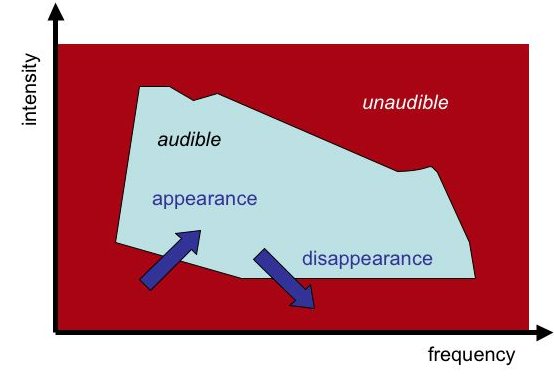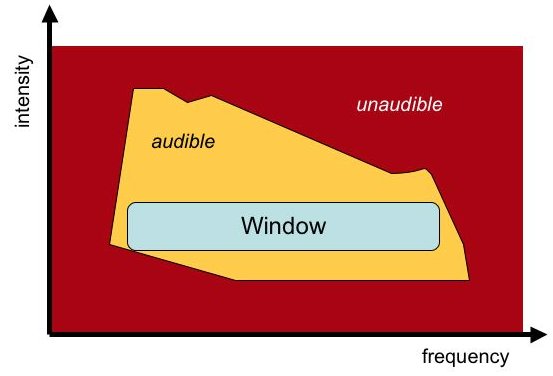Imaginary music (PRELIMINARY ENGLISH VERSION)
[home] <<summary <preceding
next>
[Français
![]() ]
]
The first part made us go through the three dimensions of the musical space.
Let us summarize :
|
The duration is of discrete nature (it can be divided into elements): elements are the intervals of time between sound events. The interesting limits are the beginning and the end of the work. The presence is of continuous nature, limited by the thresholds of audibility and pain. The relations between objects are of type equality or dominating / dominated. The color has a harmonic constituent, of continuous or discrete nature, limited by the frequencies 20 Hz - 20 kHz, and a dynamic constituent. The relations between objects are of the set theory type: disjunction, jointure, intersection of the spectres of frequencies . |
We describe now the sound landscape by referring to these three dimensions, which provide the frame of our white sheet. The sound objects which we hear move through this space.
But, as the painter or the draftsman, the composer settles his action in a scenery (unless he looks for the environment of the interplanetary space).
This scenery includes at least two aspects :
the matter in which objects will be sculptured ;
the frame of the window (or the screen) by which they are visible (or rather: audible).
Any sound object is perceived, and thus exists, only because it possesses at the same moment three constituents: presence, duration and color. The absence of one of these constituents dematerializes the object. For example, for an object as the bells of the village church chime, if I remove the color, I shall not have more than the chime melody, if I remove the duration, I shall not have more than that church collection of sounds of bells, and if I remove the presence, I shall not have more than the memory of the last heared melody of bells.
In a given sound landscape, all the possibilities of these constituents are not used in total freedom. Really, only a predefined range is used: such or such instrument, an orchestra of such composition, the voice of so-and-so and its accompaniment, the reggae or waltz rhythm, the " big sound of a Moog synthesizer ", the 6/8 signature, the art of the fugue, the African speaking tom-tom , the " hard metal " style, the birds of the forest, ....
The sound matter is not visible: it is discovered only by palpation of the sound objects which are constituted from it. So the blind person recognizes a matter by feeling it with the hands, so the speleologist discovers the walls of the cave thanks to the beam of his electric light. In the first hitting, we recognize the piano instrument, maybe the pianist; in the first phrase we recognize the singer, or we discover him little by little by listening to his disk; a random series of "pops" on the tent cloth in the middlenight silence : the rain is coming.
Can we hear immaterial or abstract sound objects? This sensation can exist temporarily, not because the object is not constituted by sound matter, but because the listener did not recognize an usual matter. From the second hearing, the object is not immaterial any more: the sound matter, in the form of sound object, had been settled in the memory of the listener. For example, when we try to sleep at night in an unknown place, any noise questions: we try to relate it to a known consistency, as a crackle of framework, or a noise of step, or a shutter which beats, or a vehicle which passes. If the mind cannot identify such noise with regard to a familiar origin, this noise can seem extraterrestrial or devilish.
The musical research investigates fields of creation of new sound matters. But so that the understanding of its statement remains accessible to a given public, it is recommended to take into account the limits of understandability, that is, the specific capacities of assimilation of the novelty for this public. For example, to popularize a new creative approach, every produced work could limit to sculpture only in a single new matter, or to innovate in associating elements from disparate matters only if these elements are already very recognizable as such.
The sound matter thus consists of a specific underlying texture in the musical space in its different dimensions. This texture can be already settled in the collective memory related to the culture of the listeners, as the classical music for some European society, as the language of the tom-tom for initiated people in Africa. Conversely, a new texture can be recognised little by little, and become clearer as we discover an unknown art or an original creator.
Because the music takes place in a landscape which can be very different from a work to another, now let us look for the means we have to describe this landscape. We already know several approaches.
Approach by reference to instruments :
By identifying what are the instruments used to play the music (composition of the orchestra) or to emit sounds (origin of the received noises and sounds); examples: string quartet, diatonic accordion, school playground, military brass band, Indonesian gong; the reference is real, or simulated by electoacoustic synthesis.
Approach by reference to style :
By associating the music with its genre or with its composer: it is from the country blues, the dixieland, from Beethoven, the flamenco, from Duke Ellington ...
Approach by reference to a codification :
Examples in the written music: in major flat, signature in 4/4; examples in the traditional music: rumba (Spain), scottish (Brittany), varnam (India), maqam (Arab).
Approach by acoustic parameters :
Outdoors, in a studio, in a hall with public, in a church; contrasted or blurred color, pure or rich presence.
We can also use our new reference frame, by predefining a set of forms with which we shall use the duration dimension, the presence dimension and the color dimension.

Figure 1 : window on landscape (Lozère)
We had seen in the first part that the presence dimension and the color dimension are both limited at the level of the human perception by the perception thresholds, which draw a border between the audible and the inaudible, and thus bounds a window very restricted by our sensibility to the acoustic phenomena.
Animals and our measuring instruments (seismographs, ultrasound sensors) can perceive a different extent of this universe. Our field of listening is like a stage of theater, the backstage and accessories of which we cannot see, or like a cinema screen, the off-camera of which we cannot see: our system of hearing is insensible in what can take place outside its limits, as slow vibrations, ultrasounds, or tiny noises...

Figure 2 : the natural limits of the sound window
The sound objects can then appear of two possible manners:
in the most current case, by appearing in a part of the window of audibility;
by sliding from an inaudible sound level (null or too weak) tot an audible level, as when a noise gets closer..
They disappear in an inverse way..
The sound event is a more or less fast transition of an object from the outside inward of the window, or conversely. We shall compare with an entrance or exit of character into or from the stage, or to a change of film shot.
We spoke about limitations inherent to the natural possibilities of the ear. The composer can also locate his music in a more restricted and clearer square:
by voluntary limitation of the color: pitches, tones;
by voluntary limitation of the presence: spatial effects, differences of intensity levels.

Figure 3 : a sound window delineated by the composer himself
Remark : the limitations also can be due to the technical constraints of recording or transmission: signal / noise ratio, limitation in frequencies. A compressor / expander enables to act on the recording sound window like the Cinemascope optical process for the width of the screen.
By habituation, the listener will adhere to the limits of the window that the musician fixed , and he will feel as intruder any audible phenomenon out of the composed borders: too strong, too tiny, too much colored, too pure.
These limits become the limits of listening inside which the listener concentrates and, by effect of "zoom", perceives more and more fine details.
The effect of "zoom" can be continued until tiny variations, as long as the habituation allows to appreciate more and more tiny movements. However the listener will have a power of resolution physically limited by the difference threshold of the hearing.
The more or less fast changes of limits will be perceived like an evolution of the layout of the window, or as changes of film shot layout.
Imaginary music ISBN 978-2-9530118-0-7 copyright Charles-Edouard Platel
[home] <<summary <preceding top^ next>